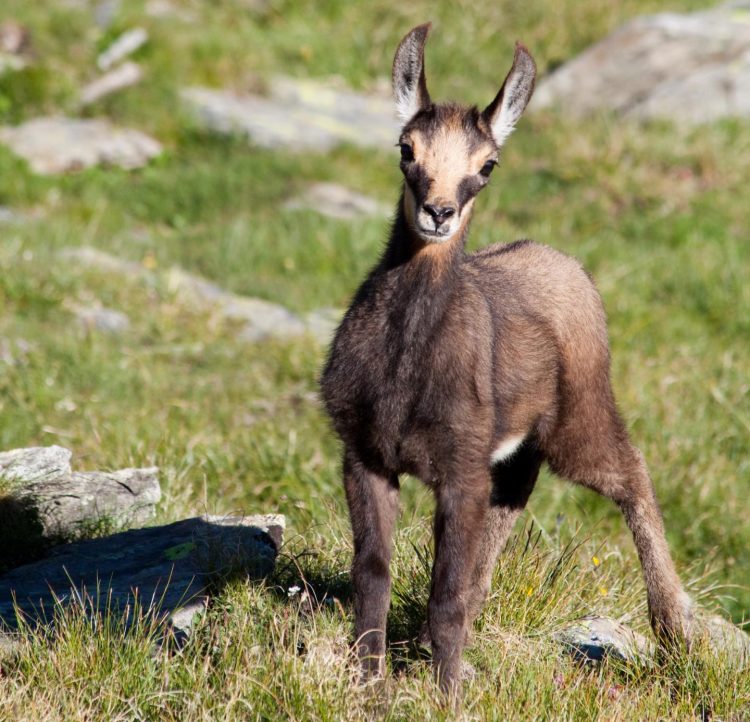'Shrinking goats' another indicator that climate change affects animal size

This is a juvenile Alpine Chamois in the Italian Alps. Credit: Tom Mason
The researchers studied the impacts of changes in temperature on the body size of Alpine Chamois, a species of mountain goat, over the past 30 years.
To their surprise, they discovered that young Chamois now weigh about 25 per cent less than animals of the same age in the 1980s.
In recent years, decreases in body size have been identified in a variety of animal species, and have frequently been linked to the changing climate.
However, the researchers say the decline in size of Chamois observed in this study is striking in its speed and magnitude.
The research, funded by the Natural Environment Research Council is published in the journal Frontiers in Zoology.
Lead author Dr Tom Mason, in the School of Biological and Biomedical Sciences, at Durham University, said: “Body size declines attributed to climate change are widespread in the animal kingdom, with many fish, bird and mammal species getting smaller.
“However the decreases we observe here are astonishing. The impacts on Chamois weight could pose real problems for the survival of these populations.”
The team delved into long-term records of Chamois body weights provided by hunters in the Italian Alps.
They discovered that the declines were strongly linked to the warming climate in the study region, which became 3-4oC warmer during the 30 years of the study.
To date, most studies have found that animals are getting smaller because the changing climate is reducing the availability or nutritional content of their food.
However, this study found no evidence that the productivity of Alpine meadows grazed by Chamois had been affected by the warming climate. Instead, the team believes that higher temperatures are affecting how chamois behave.
Co-author Dr Stephen Willis, in the School of Biological and Biomedical Sciences, at Durham University, said: “We know that Chamois cope with hot periods by resting more and spending less time searching for food, and this may be restricting their size more than the quality of the vegetation they eat.
“If climate change results in similar behavioural and body mass changes in domestic livestock, this could have impacts on agricultural productivity in coming decades.”
According to the authors, the future plight of the Chamois remains unclear.
Dr Philip Stephens, another co-author on the study, in the School of Biological and Biomedical Sciences, at Durham University, said: “The body mass of juvenile animals is critical to their ability to survive harsh winters.
“However, whether that becomes a problem will depend on the balance of future climate change between the seasons.”
The research suggests that declining body size is a result of changes in both climate and the density of animals.
To counter declining body size in future, the researchers say it might be necessary to maintain Chamois populations at lower densities than occur at present, perhaps through changes in hunting regulations.
Dr Mason added: “This study shows the striking, unforeseen impacts that climate change can have on animal populations.
“It is vital that we continue to study how climate change affects species such as Chamois. Changes in body size could act as early-warning systems for worse impacts to come, such as the collapses of populations.”
Media Contact
More Information:
http://www.durham.ac.ukAll latest news from the category: Ecology, The Environment and Conservation
This complex theme deals primarily with interactions between organisms and the environmental factors that impact them, but to a greater extent between individual inanimate environmental factors.
innovations-report offers informative reports and articles on topics such as climate protection, landscape conservation, ecological systems, wildlife and nature parks and ecosystem efficiency and balance.
Newest articles

High-energy-density aqueous battery based on halogen multi-electron transfer
Traditional non-aqueous lithium-ion batteries have a high energy density, but their safety is compromised due to the flammable organic electrolytes they utilize. Aqueous batteries use water as the solvent for…

First-ever combined heart pump and pig kidney transplant
…gives new hope to patient with terminal illness. Surgeons at NYU Langone Health performed the first-ever combined mechanical heart pump and gene-edited pig kidney transplant surgery in a 54-year-old woman…

Biophysics: Testing how well biomarkers work
LMU researchers have developed a method to determine how reliably target proteins can be labeled using super-resolution fluorescence microscopy. Modern microscopy techniques make it possible to examine the inner workings…





















